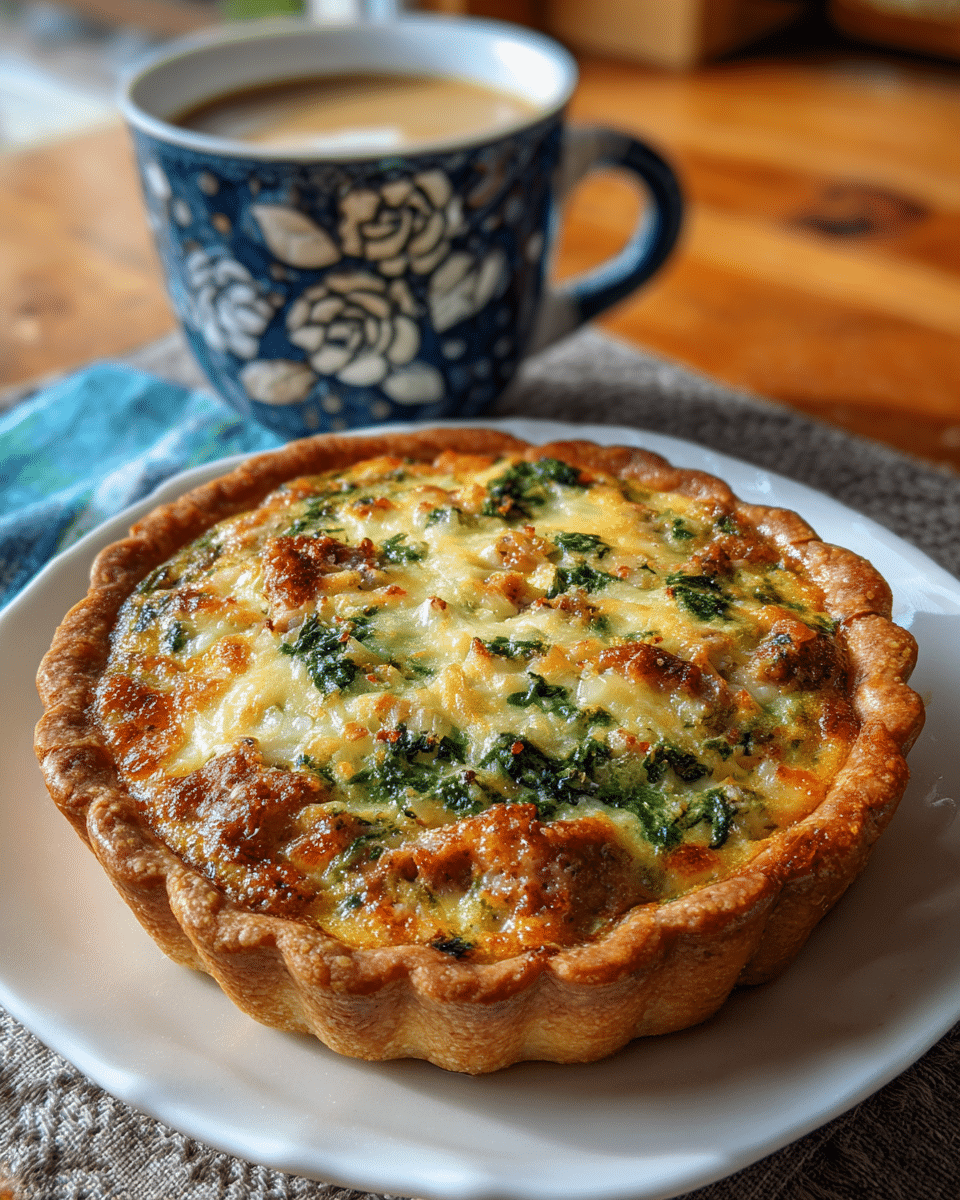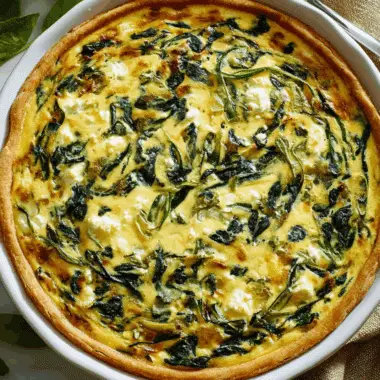A beloved French classic, Quiche Lorraine is a rich and savory tart featuring a flaky pastry crust filled with a creamy custard of eggs, cream, cheese, and crisp bacon. Perfect for breakfast, brunch, or a light lunch, this dish is elegant enough to serve at gatherings yet simple enough to prepare for a cozy meal at home. Its golden, cheesy top and buttery texture make it a timeless comfort food with gourmet appeal.
FULL RECIPE: Ingredients
1.For the crust:
- 1 1/4 cups all-purpose flour
- 1/2 tsp salt
- 1/2 cup cold unsalted butter, cubed
- 3–4 tbsp ice water
2.For the filling:
- 6 strips thick-cut bacon, chopped
- 1 medium onion, finely chopped
- 1 cup Gruyère cheese, shredded (or Swiss cheese)
- 3 large eggs
- 1 1/4 cups heavy cream (or half-and-half)
- 1/4 tsp ground nutmeg
- Salt and freshly ground black pepper, to taste
Directions
- Prepare the crust: In a mixing bowl, whisk flour and salt together. Cut in cold butter using a pastry cutter or fork until the mixture resembles coarse crumbs. Slowly add ice water, one tablespoon at a time, mixing just until the dough holds together. Form into a disc, wrap in plastic, and refrigerate for at least 30 minutes.
- Preheat the oven to 375°F (190°C). Roll out the chilled dough on a lightly floured surface into a circle about 12 inches in diameter. Fit into a 9-inch tart or pie pan, trimming any excess. Prick the bottom with a fork. Line with parchment and fill with pie weights or beans.
- Blind bake the crust: Bake for 15 minutes, then remove weights and parchment. Bake for another 10 minutes until the crust is lightly golden. Remove from oven and let cool slightly.
- Cook the bacon and onion: In a skillet over medium heat, cook chopped bacon until crispy. Remove with a slotted spoon and set aside. In the remaining fat, sauté onions until soft and translucent, about 5–6 minutes. Remove from heat.
- Assemble the filling: In a medium bowl, whisk together eggs, cream, nutmeg, salt, and pepper. Stir in cooked bacon, onions, and shredded cheese.
- Fill and bake: Pour the filling into the pre-baked crust. Bake for 30–35 minutes, or until the center is set and lightly golden on top. Let rest for 10 minutes before slicing.
- Serve warm or at room temperature. Perfect with a side salad or fruit.
Nutrition Facts
- Calories: 405
- Total Fat: 32g
- Saturated Fat: 16g
- Trans Fat: 0.5g
- Cholesterol: 145mg
- Sodium: 460mg
- Total Carbohydrates: 17g
- Dietary Fiber: 1g
- Sugars: 2g
- Protein: 12g
- Calcium: 200mg
- Iron: 1.5mg
- Potassium: 150mg
The Origin of Quiche Lorraine
Quiche Lorraine hails from the Lorraine region of northeastern France, a place known for its rustic yet refined culinary traditions. Originally a simple custard tart made with eggs and cream, it evolved with the addition of bacon and cheese to become the iconic dish we know today. The name “quiche” derives from the German word “kuchen,” meaning cake, reflecting the region’s blend of French and German influences. This culinary heritage adds a rich cultural dimension to the recipe.
Why Quiche Lorraine is a Brunch Classic
Over time, Quiche Lorraine earned a special spot on brunch menus worldwide. Its balance of creamy filling and savory bacon makes it both indulgent and satisfying, perfect for late-morning meals. The dish is versatile enough to pair with light salads or fruit, allowing it to be part of a full brunch spread. Its beautiful golden color and inviting aroma also make it visually appealing when served at gatherings or special occasions.
The Role of the Crust
The crust in a Quiche Lorraine provides the essential structure and contrast to the soft filling. Traditionally, a buttery pâte brisée (shortcrust pastry) is used, offering a flaky, melt-in-the-mouth texture. A well-baked crust acts as the perfect canvas for the rich custard, helping prevent sogginess and enhancing the overall eating experience. This makes it crucial to blind bake the crust before adding the filling.
Importance of Blind Baking
Blind baking the crust helps maintain its crispness and prevents it from absorbing moisture from the egg custard. This step is essential to avoid a soggy bottom, a common issue in quiche-making. By baking the crust partially before filling it, you create a barrier that locks in flavor and texture. It also ensures that the crust holds its shape during baking.
The Power of Eggs and Cream
Eggs and cream form the foundation of the quiche filling, delivering that signature custardy texture. The ratio between the two is key to achieving the ideal consistency—not too runny, not too firm. Heavy cream creates a silkier texture, while using half-and-half or milk results in a lighter dish. Proper whisking of the eggs ensures even distribution and a smooth finish.
The Distinctive Flavor of Gruyère
Gruyère cheese is a hallmark ingredient in traditional Quiche Lorraine, adding depth and a slightly nutty flavor. This Swiss cheese melts beautifully and complements the richness of the custard without overpowering it. It also browns nicely, giving the quiche a golden, appetizing surface. Some variations substitute Emmental or a mild cheddar, but Gruyère remains the gold standard.
Bacon: The Heart of the Flavor Profile
Bacon provides the savory backbone of Quiche Lorraine. Its saltiness and crisp texture balance the richness of the custard, and its fat adds depth to the overall flavor. High-quality, thick-cut bacon is typically preferred for its hearty bite. Cooking it beforehand ensures it remains flavorful and doesn’t release excess grease into the filling.
Inclusion of Onions and Nutmeg
While traditionalists may argue against it, many modern versions of Quiche Lorraine include sautéed onions for sweetness and complexity. Nutmeg, though used sparingly, enhances the custard with warm, earthy undertones. These subtle additions elevate the dish without deviating too far from its roots. They add aroma and balance that take the recipe to the next level.
Versatility of Serving Options
Quiche Lorraine can be enjoyed hot, warm, or even cold. Served with a crisp green salad or a light soup, it makes a complete meal. It’s ideal for breakfast, brunch, lunch, or a light dinner. Because it can be made ahead and reheated, it’s a convenient choice for hosts and busy families alike.
Meal Prep and Storage Benefits
Quiche Lorraine is an excellent meal prep option. It stores well in the refrigerator for up to 4 days and can be frozen for longer periods. Individual slices can be reheated in a toaster oven or microwave for a quick and satisfying meal. This convenience makes it a go-to recipe for planning weekly menus or hosting brunches.
Dietary Modifications and Substitutions
While the traditional recipe is rich and indulgent, it can be modified to suit different dietary needs. For a lighter version, use milk instead of cream and reduce the cheese. For vegetarians, omit the bacon and add sautéed mushrooms or spinach. Gluten-free crusts can also be used without sacrificing too much of the dish’s integrity.
Quiche Lorraine vs. Other Quiches
Unlike veggie-loaded or seafood quiches, Quiche Lorraine focuses on a simpler, more refined flavor profile. The lack of competing ingredients allows the bacon, cheese, and custard to shine. This makes it an ideal starting point for those new to making quiche. Once mastered, you can experiment with other flavor combinations confidently.
Pairing Ideas for a Full Meal
To elevate the meal, serve Quiche Lorraine with complementary sides like a mixed greens salad with vinaigrette, roasted asparagus, or fruit salad. A crisp white wine such as Sauvignon Blanc or a mimosa adds elegance to a brunch spread. These pairings enhance the dining experience and create a well-rounded menu.
Perfect for Entertaining Guests
Quiche Lorraine is an ideal dish for entertaining due to its make-ahead convenience and wide appeal. Its elegant appearance and rich flavor make it suitable for baby showers, bridal brunches, holiday breakfasts, or office potlucks. A single quiche can serve up to 8 people, making it both practical and impressive.
Tips for the Perfect Quiche Texture
For a silky, custard-like interior, don’t overbake the quiche. The center should be set but slightly wobbly when removed from the oven. It will continue to firm up as it cools. Overbaking can lead to a rubbery texture or cause the custard to separate. Allowing it to rest before slicing ensures cleaner cuts and better presentation.
Cultural Influence and Popularity Worldwide
Though deeply rooted in French culinary tradition, Quiche Lorraine has gained international popularity. It’s now found in cafés, bakeries, and home kitchens across the globe. Its reputation as a sophisticated yet approachable dish makes it a staple in both casual and upscale dining. The fusion of rustic charm and gourmet flavor explains its global appeal.
Conclusion
Quiche Lorraine endures because of its simplicity, versatility, and rich flavor. Whether served as part of a festive brunch or a weekday lunch, it delivers comfort and elegance in equal measure. Its balance of creamy custard, crisp bacon, and flaky crust makes it a dish that transcends time and trend. From French kitchens to global tables, it remains a celebrated classic.








